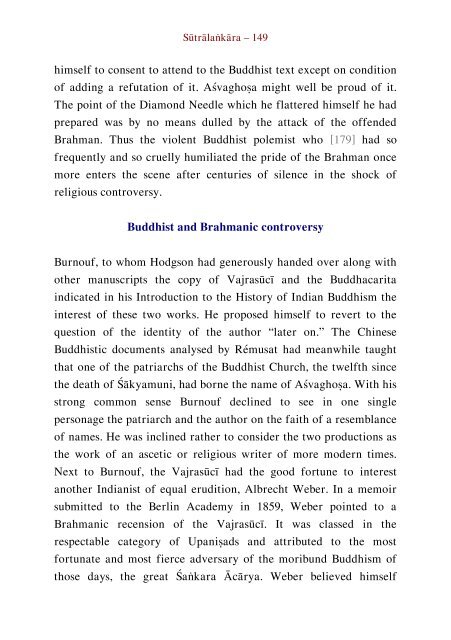Literary History of Sanskrit Buddhism
A study by J. K. Nariman of Sanskrit Buddhism from the Early Buddhist Tradition up to the Mahayana texts proper.
A study by J. K. Nariman of Sanskrit Buddhism from the Early Buddhist Tradition up to the Mahayana texts proper.
You also want an ePaper? Increase the reach of your titles
YUMPU automatically turns print PDFs into web optimized ePapers that Google loves.
Sūtrālaṅkāra – 149<br />
himself to consent to attend to the Buddhist text except on condition<br />
<strong>of</strong> adding a refutation <strong>of</strong> it. Aśvaghoṣa might well be proud <strong>of</strong> it.<br />
The point <strong>of</strong> the Diamond Needle which he flattered himself he had<br />
prepared was by no means dulled by the attack <strong>of</strong> the <strong>of</strong>fended<br />
Brahman. Thus the violent Buddhist polemist who [179] had so<br />
frequently and so cruelly humiliated the pride <strong>of</strong> the Brahman once<br />
more enters the scene after centuries <strong>of</strong> silence in the shock <strong>of</strong><br />
religious controversy.<br />
Buddhist and Brahmanic controversy<br />
Burnouf, to whom Hodgson had generously handed over along with<br />
other manuscripts the copy <strong>of</strong> Vajrasūcī and the Buddhacarita<br />
indicated in his Introduction to the <strong>History</strong> <strong>of</strong> Indian <strong>Buddhism</strong> the<br />
interest <strong>of</strong> these two works. He proposed himself to revert to the<br />
question <strong>of</strong> the identity <strong>of</strong> the author “later on.” The Chinese<br />
Buddhistic documents analysed by Rémusat had meanwhile taught<br />
that one <strong>of</strong> the patriarchs <strong>of</strong> the Buddhist Church, the twelfth since<br />
the death <strong>of</strong> Śākyamuni, had borne the name <strong>of</strong> Aśvaghoṣa. With his<br />
strong common sense Burnouf declined to see in one single<br />
personage the patriarch and the author on the faith <strong>of</strong> a resemblance<br />
<strong>of</strong> names. He was inclined rather to consider the two productions as<br />
the work <strong>of</strong> an ascetic or religious writer <strong>of</strong> more modern times.<br />
Next to Burnouf, the Vajrasūcī had the good fortune to interest<br />
another Indianist <strong>of</strong> equal erudition, Albrecht Weber. In a memoir<br />
submitted to the Berlin Academy in 1859, Weber pointed to a<br />
Brahmanic recension <strong>of</strong> the Vajrasūcī. It was classed in the<br />
respectable category <strong>of</strong> Upaniṣads and attributed to the most<br />
fortunate and most fierce adversary <strong>of</strong> the moribund <strong>Buddhism</strong> <strong>of</strong><br />
those days, the great Śaṅkara Ācārya. Weber believed himself


















